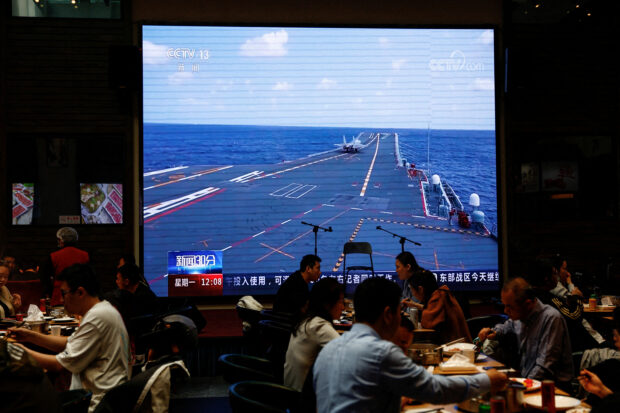China rocket launch sends debris into sea near Taiwan: Taipei authorities

Customers dine near a giant screen broadcasting news footage of an aircraft taking off from China’s Shandong aircraft carrier while taking part in a combat readiness patrol and “Joint Sword” exercises around Taiwan conducted by the Eastern Theatre Command of China’s People’s Liberation Army (PLA), at a restaurant in Beijing, China on April 10, 2023. (REUTERS)
TAIPEI – China said Sunday it had launched a satellite into orbit, with authorities in Taiwan saying rocket debris had fallen into the sea where Beijing announced a no-sail zone this week.
Maritime authorities in China’s eastern Fujian province this week banned ships from an area north of Taiwan from 9:00 am (0100 GMT) to 3:00 pm (0700 GMT) on Sunday due to “possible falling rocket wreckage”.
Taiwan’s transport ministry said Beijing had also planned to prohibit aircraft from entering the zone — criss-crossed by a number of international routes — for around half an hour from 9:30 am, though Chinese authorities later criticized the claim as inaccurate.
The announcements came days after Beijing declared an end to large-scale military drills around Taiwan carried out as a furious response to its leader Tsai Ing-wen’s recent visit to the United States.
Chinese state media on Sunday announced the successful launch of a “new meteorological satellite” from a space centre in northwestern China at 9:36 am.
Footage released by state broadcaster CCTV showed a white rocket blasting off into clear skies from the launch centre in arid Gansu province, leaving a plume of smoke and dust in its wake.
Taipei’s defense ministry said the satellite’s orbit “passed over the seas off (the) northern coast of Taiwan” and that “some rocket wreckage fell into the warning area”.
“The military has used joint intelligence, surveillance and reconnaissance measures to monitor the situation of the rocket launch,” the ministry said.
The debris “did not affect our homeland security”, it added.
Beijing’s Xinhua news agency reported that the launch of the Long March 4B rocket had carried the Fengyun-3 07 satellite “into its preset orbit”.
The satellite “will provide services for weather forecasting, disaster prevention and mitigation, climate change response and ecological conservation”, according to Xinhua.
Military drills
China views Taiwan as part of its territory and has vowed to bring the self-ruled island under its control one day — by force if need be.
Beijing this month held three days of “Joint Sword” military maneuvers after Tsai travelled to the US — Taipei’s main security backer — for meetings with a bipartisan group of lawmakers including House Speaker Kevin McCarthy.
China’s People’s Liberation Army said the exercises simulated targeted strikes on Taiwan and an encirclement that would have effectively “sealed” it off.
The operations “comprehensively tested the integrated joint combat ability of multiple military branches under actual combat conditions”, the PLA’s Eastern Command said.
They were also expected to include live-fire drills in a closed-off area near the coast of Fujian — about 80 kilometers (50 miles) south of the Taiwan-administered Matsu islands — but it is not clear whether those drills actually took place.